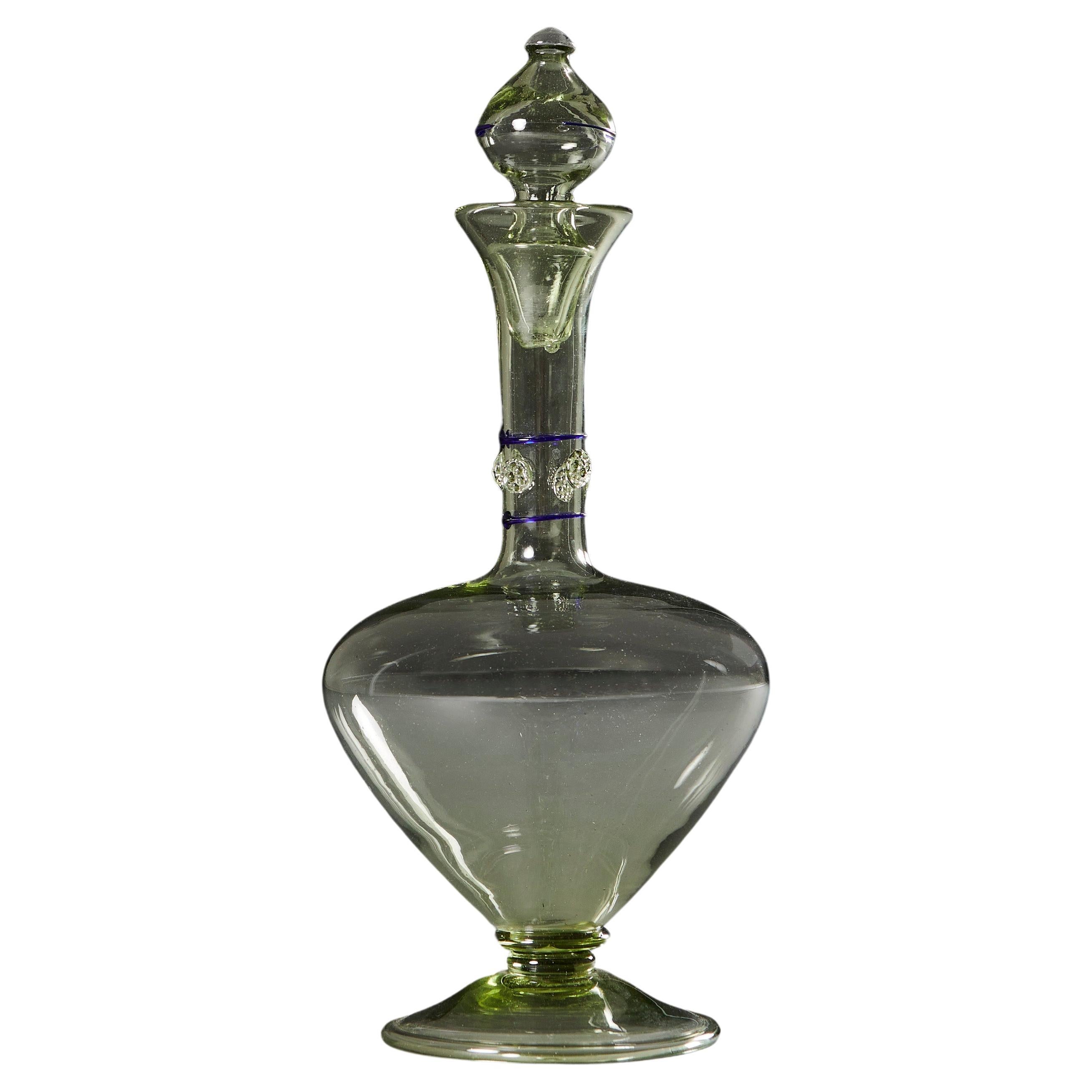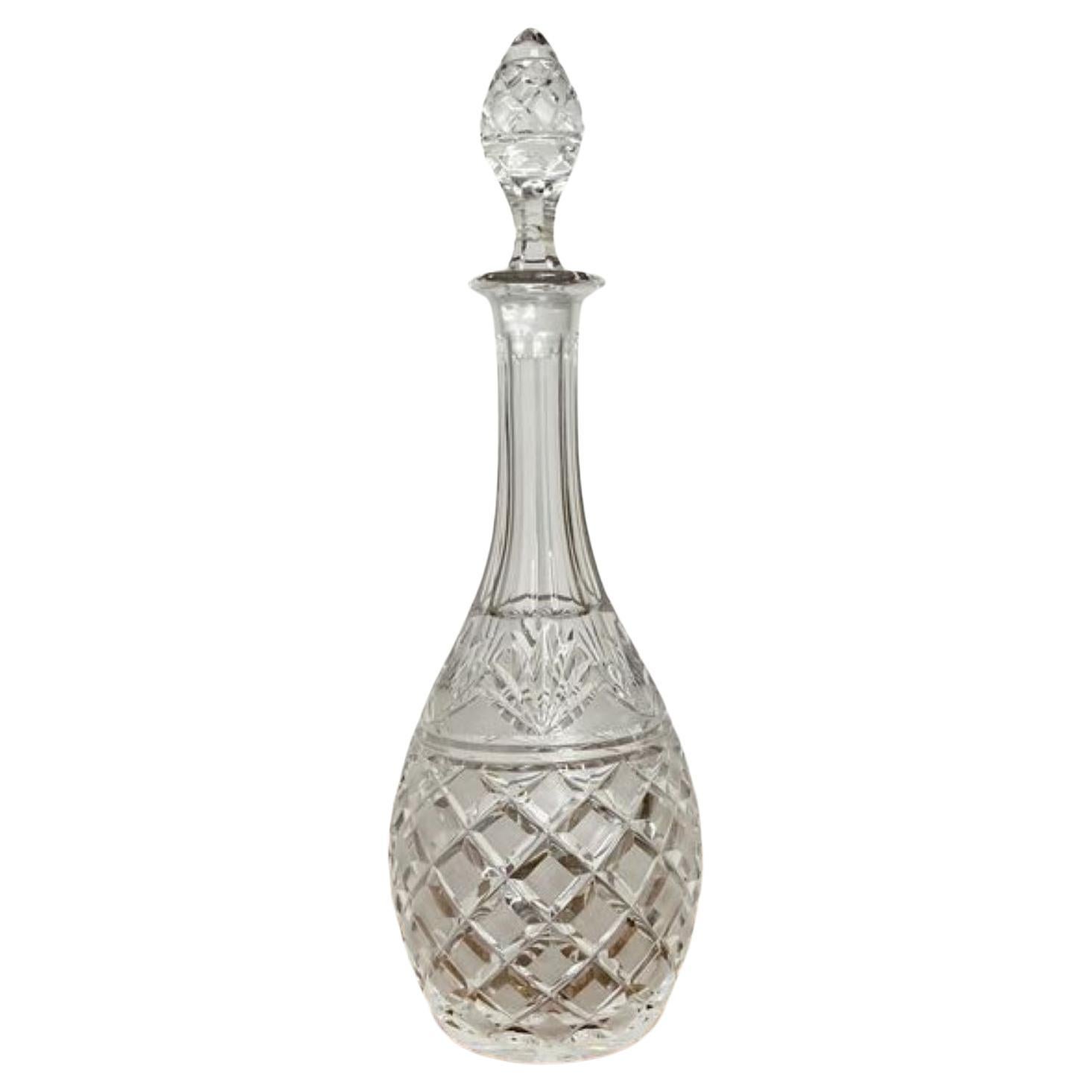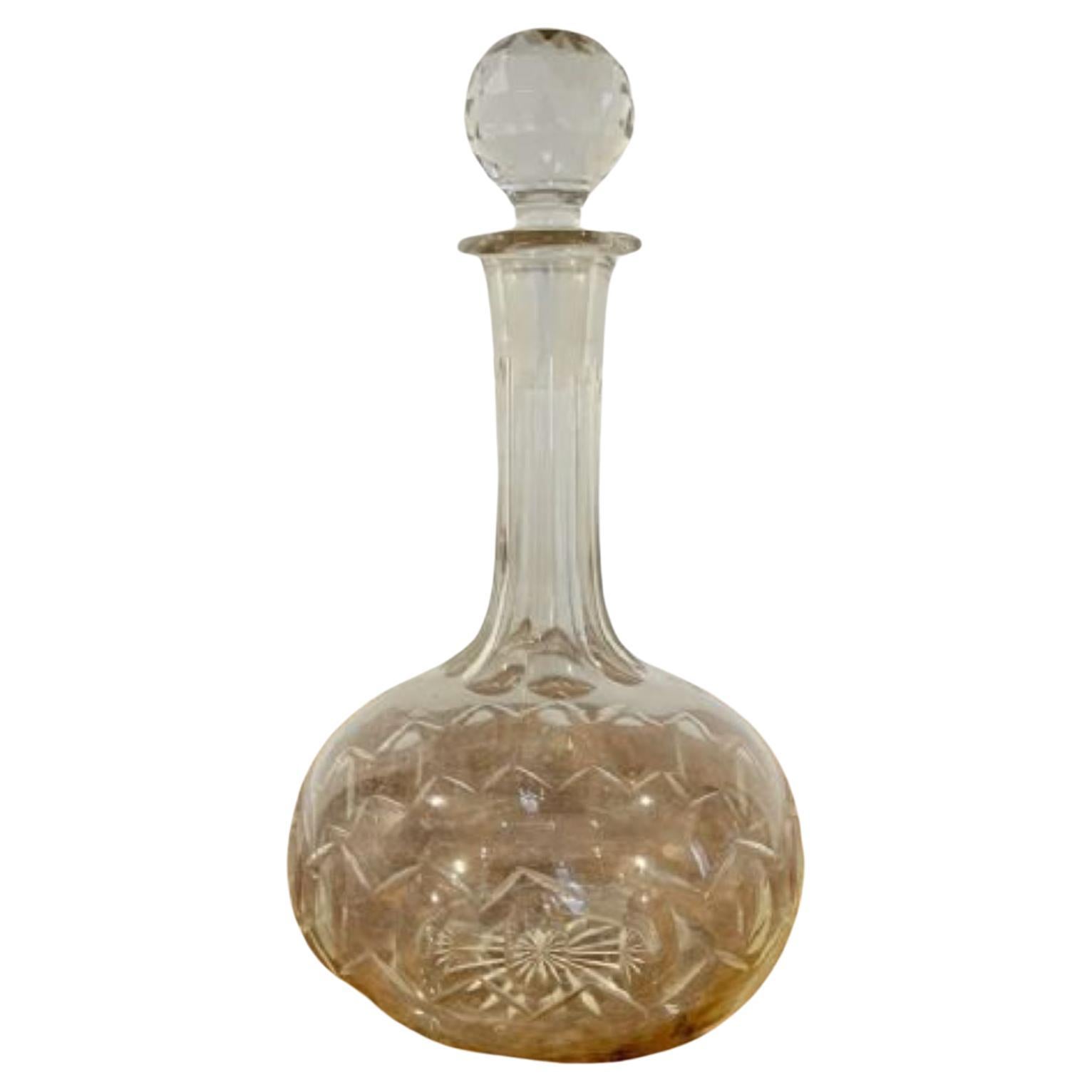Items Similar to Peacock Green Cut-Glass Decanter
Want more images or videos?
Request additional images or videos from the seller
Peacock Green Cut-Glass Decanter
About the Item
Peacock green cut-glass decanter
English, circa 1840.
Glass, blown and cut.
Measures: 13 1/2 in. high.
Condition: Perfect, except for minor flakes on the bottom of stopper.
- Dimensions:Height: 13.5 in (34.29 cm)Diameter: 6 in (15.24 cm)
- Style:Neoclassical (Of the Period)
- Materials and Techniques:
- Place of Origin:
- Period:
- Date of Manufacture:circa 1840
- Condition:Wear consistent with age and use. CONDITION: Perfect, except for minor flakes on the bottom of stopper.
- Seller Location:New York, NY
- Reference Number:
About the Seller
No Reviews Yet
Recognized Seller
These prestigious sellers are industry leaders and represent the highest echelon for item quality and design.
Established in 1952
1stDibs seller since 2010
Associations
Art Dealers Association of America
- ShippingRetrieving quote...Ships From: New York, NY
- Return PolicyThis item cannot be returned.
More From This SellerView All
- Monumental Clear Cut-Glass Covered CompoteLocated in New York, NYMonumental clear cut-glass covered compote, circa 1820. La Cristallerie de Vonêche (active 1802-30), Belgium. Glass, blown and cut. Measures: 17 3/8 i...Category
Antique Early 19th Century Belgian Neoclassical Tableware
MaterialsBlown Glass, Cut Glass
- Pair of "Old Paris" Vases with Garlands of Bisquit FlowersLocated in New York, NYFrench, circa 1820. Porcelain, painted and gilded, with applied bisquit flowers 8 13/16 in. high. Inscribed (with incised mark, under the base of each): 3.Category
Antique 1820s French Neoclassical Porcelain
MaterialsPorcelain
- Plateau in the Restauration Taste with Grape and Leaf MotifsLocated in New York, NYFrench. Plateau in the Restauration taste with grape and leaf motifs, circa 1825. Ormolu and patinated bronze, with mirror plate and wood backing. Measures: 15 7/8 in. diameter, 3 11...Category
Antique 1820s French Neoclassical Platters and Serveware
MaterialsBronze
- Pair of Porcelain Urn Form Fruit Coolers with Covers and LinersBy Stône, Coquerel, and Legros d'AnisyLocated in New York, NYPair Footed Fruit Coolers, about 1810-20 Stône, Coquerel, and Legros D’Anisy, Paris (active 1808–49) Porcelain, partially transfer printed in sepia and green and gilded Each, 13 1/2 in. high x 10 in. wide x 7 1/2 in. deep Signed and inscribed (on underside of one top and one base, with printed mark): STÔNE / COQUEREL / ET / LE GROS / PARIS / PAR BREVET D’INVENTION: Manufre de Décors sur Porcelaine Faience; variously inscribed with decorators’ initial in green and brown (on underside of one top and one base): M; variously inscribed with incised mark (on underside of one liner and both bottoms): 3; inscribed (in blue script, on the inside of one liner): 615 The Parisian firm of Stône, Coquerel, and Legros d'Anisy is distinguished for the important role that it played in the introduction of transfer-printed decoration on fine china in France. Although the process had been known and used in Great Britain since the eighteenth century, it was, according to Régine de Plinval de Guillebon in her book, Porcelain of Paris 1770–1850 (New York: Walker and Company, 1972), not until 1802 that Potter, Blancheron, Constant, Neppel, Cadet de Vaux & Denuelle took out a patent in France for transfer-printing on earthenware, and it was only on February 26, 1808, that John Hurford Stône, his brother-in-law, Athanase Marie Martin Coquerel, and Francois Antoine Legros d'Anisy not only took out a patent for transfer-printing on china, but also established a Stône, Coquerel, and d'Anisy partnership for the manufacture of transfer-printed ceramics. Their address from 1808 until 1818 was at 9, rue de Cadran, Paris. Prior to this, Stône and Coquerel had been partners at a creamware factory in Creil, France, and Legros d’Anisy had worked at the Sèvres factory, where he had apparently developed the transfer-printing technique for which his own firm became well known. “The process,” notes de Guillebon, was “based upon removing from the engraving a ‘pull’ made on a specially coated filter-paper, which was pressed onto the object to be decorated; this object itself was covered with a film. Firing took...Category
Antique Early 19th Century French Neoclassical Wine Coolers
MaterialsPorcelain
- Fan-Carved Wood Mantel in the Federal TasteLocated in New York, NYNew York, Fan-carved mantel in the Federal taste, circa 1812 Pine Measures: 66 1/4 in. high, 90 3/8 in. wide, 13 1/4 in. deep Within the genre of carved rather than plasterwork mantels of the Federal Period, no example that has come to light is more perfectly designed or more carefully wrought than the present one, which is an amazing symphony of fans, urns, beads, and other Neo-Classical devices, all ultimately influenced by the plasterwork designs of the English architects Robert (1728–1792) and James (1732–1794) Adam. Of a type that proliferated in the area bounded by the northern New Jersey counties of Bergen and Passaic, the Hudson Valley, and western Long Island, the mantel is representative of work that flourished in the first couple of decades of the 19th century. While most of the woodwork of this style that has survived is found in interiors, various examples of exterior doors and other trim have been noted, but most examples have disappeared as a result, variously, of natural deterioration and purposeful demolition in anticipation of development. Although considerably larger in scale and more elaborate in ornament than a mantel that has been in the collection of the Brooklyn Museum since 1944 (acc. no. 44.55; photograph in Hirschl & Adler archives), the present mantel is so close in style and conception to that example that it likely originated in the same house. The Brooklyn mantel is documented as having been removed from a house built by Judge Isaac Terhune (1762–1837), an eminent lawyer and judge. The house was situated on King’s Highway, at the corner of Mansfield Place, at the edge of South Greenfield, a village in northern Gravesend, Brooklyn. A photograph of the house, taken by the German e´migre´ photographer, Eugene Armbruster (1865–1933), is in the collection of the New-York Historical Society. Terhune is ultimately descended from the Dutch-Huguenot e´migre´ Albert Albertson Terhunen, who died in Flatlands, Brooklyn, in 1685.The family eventually spread out through New Amsterdam, Long Island, and Bergen County, New Jersey. Terhune’s great-grandson, also Albert (1715–1806), left a sizable estate to his six surviving children, including his second child and second son, Isaac. Judge Terhune lived in the house until his death in 1837, at which time, according to an article in The New York Times for November 27, 1910, he, having died without issue, “left the White Frame Mansion with its exquisitely carved doorway, beautiful mantels, and other interior adornments to his brother John” (Part Six, p. 11). The article continues: After the latter’s death, the house and its estate of about 70 acres passed through several owners, eventually being purchased in 1853 by Benjamin G. Hitchings [1813–1893]. The house next passed to Benjamin’s son, Hector, who had been born in the house, and then lived there for 25 years. He sold it in 1910 in partial payment for a Manhattan apartment house. After thus having been sold to a real estate developer, the Hitchings property was subdivided into Hitchings Homestead. The house survived until about 1928, at which time it was razed and a Deco-style apartment house with the address 2301 Kings Highway was constructed on the site and occupied in 1935. By 1910, the fate of the house, in an area of Brooklyn that was being rapidly developed, was becoming obvious. The Times article reported: The house has been well kept up, but fearing lest the hand of time or vandals might deal harshly with some of its choice bits of carving, Mr. Hitchings removed a few years ago a few beautifully carved wood mantels...Category
Antique 1810s American Neoclassical Fireplaces and Mantels
MaterialsWood
- Butler's Desk and Etagére, New York, Possibly Duncan PhyfeBy Duncan PhyfeLocated in New York, NYButler’s Desk and Etagére, circa 1825 New York, possibly by Duncan Phyfe Mahogany (secondary woods: mahogany, pine, poplar), with ormolu mounts, marble,...Category
Antique 1820s American Neoclassical Cabinets
MaterialsMahogany
You May Also Like
- Pair Of Emerald Green Cut Glass Ships DecantersLocated in Essex, MAEach with flat botton for ship use with silver plate stoppers one port and other rum.Category
Antique 1880s English Glass
MaterialsSilver Plate
- Star Cut Glass DecanterLocated in Chillerton, Isle of WightStar cut glass decanter. A Classic of its time this lovely piece is in good condition, it has a delightful well balanced shape dating from the mid...Category
Mid-20th Century Arts and Crafts Glass
MaterialsCrystal
- A Murano Green Glass DecanterLocated in London, GBItaly, circa 1940 An early twentieth century Murano green glass decanter, with applied decoration to the neck and stopper, supported on a circular base. Height 32.00cm Diameter ...Category
Mid-20th Century Italian Glass
MaterialsGlass
- Vintage Cut Crystal Glass DecanterLocated in London, GBA superb crystal decanters and stopper, signed to the base, Royal Brierley, mid 20th century in date. The decanter features a shouldered cylindrical form with collar neck. The bo...Category
Vintage 1950s English Glass
MaterialsCrystal
- Quality antique cut glass decanterLocated in Ipswich, GBQuality antique cut glass decanter. Having a pear shaped quality cut glass decanter with the original cut glass stopper. D.1900Category
Early 20th Century Glass
MaterialsGlass
- Antique Edwardian cut glass decanterLocated in Ipswich, GBAntique Edwardian cut glass decanter having a quality cut glass decanter with the original stopperCategory
Early 20th Century Edwardian Glass
MaterialsGlass
Recently Viewed
View AllMore Ways To Browse
Silver Peacocks
Green Stopper
Peacock Ceramics
Green Decanters
Green Glass Decanter
Antique Green Decanter
Antique Green Glass Decanter
Antique Green Glass Decanters
Murano Pulcino
Swedish Glass Goblets
Antique Venetian Wine Glasses
Moser Crystal Decanter
Murano Wine Glasses 6
Murano Vistosi Pulcino
Blenko Blue Decanter
Lalique Drinking Glasses
Lalique Drinking Glass
Glass Pickling Jar





